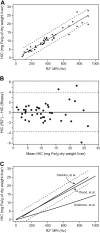R2* magnetic resonance imaging of the liver in patients with iron overload
- PMID: 19264677
- PMCID: PMC2686136
- DOI: 10.1182/blood-2008-12-191643
R2* magnetic resonance imaging of the liver in patients with iron overload
Abstract
R2* magnetic resonance imaging (R2*-MRI) can quantify hepatic iron content (HIC) by noninvasive means but is not fully investigated. Patients with iron overload completed 1.5T R2*-MRI examination and liver biopsy within 30 days. Forty-three patients (sickle cell anemia, n = 32; beta-thalassemia major, n = 6; and bone marrow failure, n = 5) were analyzed: median age, 14 years, median transfusion duration, 15 months, average (+/-SD) serum ferritin 2718 plus or minus 1994 ng/mL, and average HIC 10.9 plus or minus 6.8 mg Fe/g dry weight liver. Regions of interest were drawn and analyzed by 3 independent reviewers with excellent agreement of their measurements (intraclass correlation coefficient = 0.98). Ferritin and R2*-MRI were weakly but significantly associated (range of correlation coefficients among the 3 reviewers, 0.41-0.48; all P < .01). R2*-MRI was strongly associated with HIC for all 3 reviewers (correlation coefficients, 0.96-0.98; all P < .001). This high correlation confirms prior reports, calibrates R2*-MRI measurements, and suggests its clinical utility for predicting HIC using R2*-MRI. This study was registered at www.clinicaltrials.gov as #NCT00675038.
Figures

References
-
- Anderson LJ, Holden S, Davis B, et al. Cardiovascular T2-star (T2*) magnetic resonance for the early diagnosis of myocardial iron overload. Eur Heart J. 2001;22:2171–2179. - PubMed
-
- St Pierre TG, Clark PR, Chua-Anusorn W, et al. Noninvasive measurement and imaging of liver iron concentrations using proton magnetic resonance. Blood. 2005;105:855–861. - PubMed
-
- Ishak K, Baptista A, Bianchi L, et al. Histological grading and staging of chronic hepatitis. J Hepatol. 1995;22:696–699. - PubMed
-
- Yohai VJ. High breakdown point and high efficiency robust estimates for regression. Ann Stat. 1987;15:642–656.
Publication types
MeSH terms
Substances
Associated data
Grants and funding
LinkOut - more resources
Full Text Sources
Other Literature Sources
Medical

